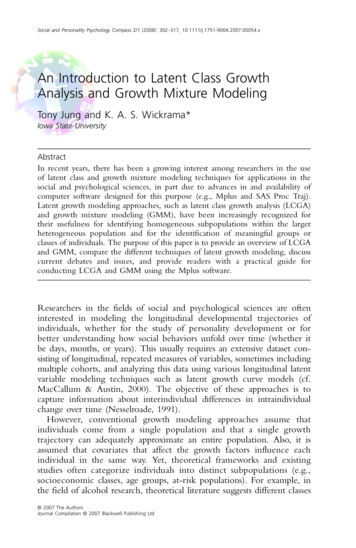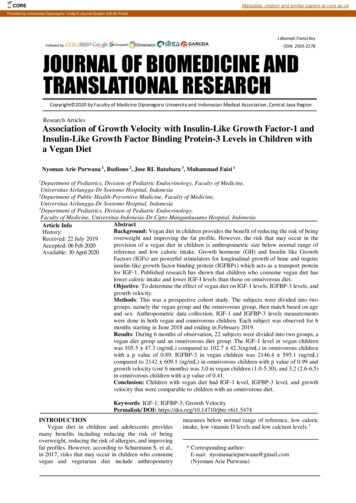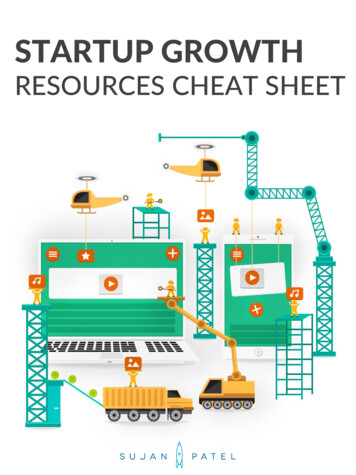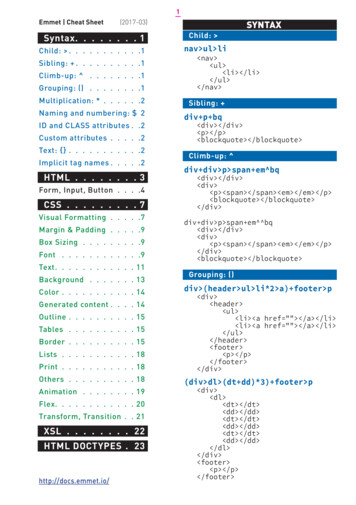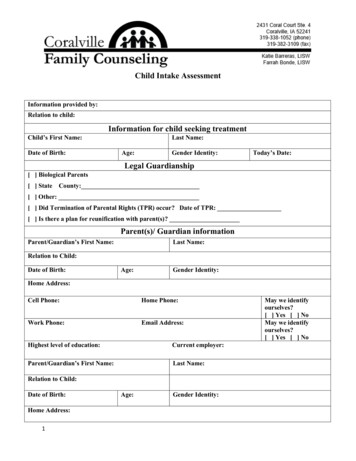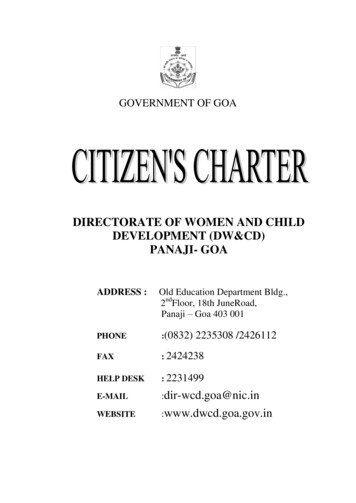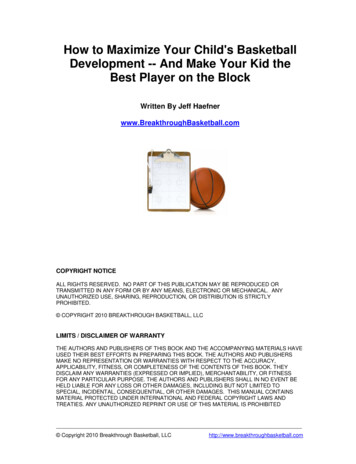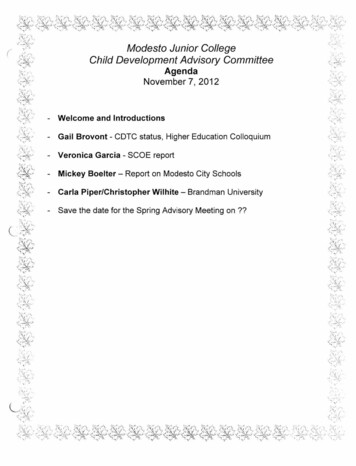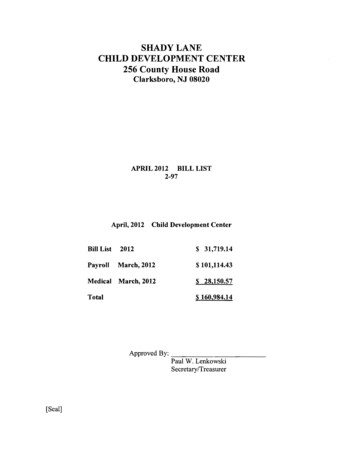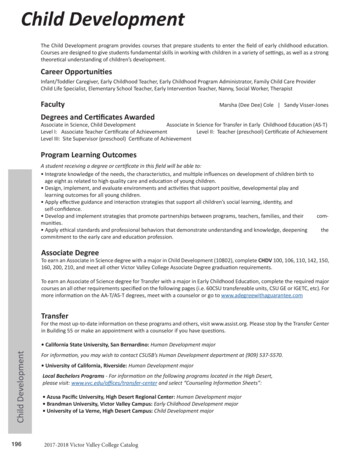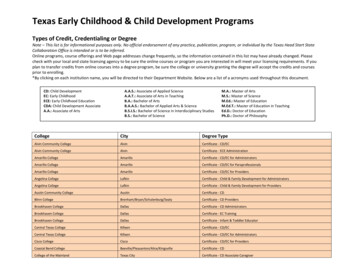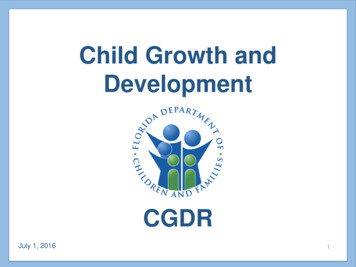
Transcription
Child Growth andDevelopmentCGDRJuly 1, 20161
IconsSeveral icons are used throughout this course as a visualreference.This icon represents a new topic in the text. This is a visual cue foryou to answer any questions about the previous section beforemoving along to the next one.This icon is used to identify a specially designed activity thatrequires active class participation.This icon is used to identify a section that is accompanied by avideo.This icon is used to identify a key point in the material.This icon is used to identify an online resource. You will need acomputer with an internet connection to view these resources.Child Growth and Development2
Child Growth and DevelopmentModule 1: Principles of ChildGrowth and DevelopmentPG – 13
Module Goal and LearningObjectivesGoalParticipants will understand the basic principles of child growthand development and how these principles apply to children’slearning.Learning ObjectivesAfter successfully completing this module, you will be able to: Explain the difference between growth and development Describe each of the basic principles of child growth anddevelopment Provide at least one implication of a development principle asit relates to child learningPG – 1Child Growth and Development4
Activity:Sharing QuestionsWrite at least two goals or expectations for this course.What is one question you have about the content of thiscourse on child growth and development?PG – 2Child Growth and Development5
Basics of Child Growth Growth refers to specific body changes and increasesin the child’s size. Development typically refers to an increase incomplexity, a change from relatively simple to morecomplicated.PG – 2Child Growth and Development6
Principles Child Growth Define growth as specific body changes and increasesin the child’s size.Similarities in growth: Growth proceeds from the head downward and from thecenter of the body outward.Differences in growth: Differences are completely typical. Typical growth issupported by good nutrition, adequate sleep, andregular exercise.PG – 3Child Growth and Development7
Principles Child Growth It is important to help the children in your care understandthat differences in growth patterns are typical. If you detect that a child is self-conscious about her size,how would you help her work on increasing her selfacceptance? If you have some concern about a growth-related issueabout a child, how would you approach this issue with theparent(s)?PG – 3Child Growth and Development8
Key PointGrowth is defined as specificbody changes and increases inthe child’s size, proceeding fromthe head downward and from thecenter of the body outward.PG – 3Child Growth and Development9
Key PointDevelopment refers to an increasein complexity; a change fromrelatively simple to morecomplicated.PG – 4Child Growth and Development10
Key PointDevelopment usually involves aprogression along a continuoussequential pathway on which thechild acquires more refinedknowledge, behaviors, and skills.PG – 4Child Growth and Development11
Key PointThe developmental sequence isbasically the same for all children;however, the rate of developmentvaries from child to child.PG – 4Child Growth and Development12
Principles of ChildDevelopmentPrinciple 1 – Developmental Sequence is Similar for All Children develop in relatively the same ways. There is a typical sequence of development that occurs as achild grows. While the sequence is similar, and the behaviors or skillsemerge in the same order, children can take more or less timewith each behavior or skill.PG – 4Child Growth and Development13
Principles of ChildDevelopmentPrinciple 2 – Development Proceeds from General to Specific Development progresses from a beginning point moving in a forwarddirection. Just as growth of an infant proceeds from the top down and from thecenter of the body to the limbs, development of behaviors and skillsmoves from general to specific. Development continues in the smaller muscles in the fingers and toes,and results in the ability of the fingers to grasp objects and the toes tohelp with balance when standing and walking.PG – 4Child Growth and Development14
Principles of ChildDevelopmentPrinciple 3 – Development is Continuous In children who develop typically, behaviors and skills they havealready acquired become the basis for new behaviors and skills. Children continue to add new behaviors and skills as they perfecttheir abilities to walk, to write or draw, and to speak. The continuation of development can easily be seen in children asthey mature from age two to age twelve.PG – 5Child Growth and Development15
Principles of ChildDevelopmentPrinciple 4 – Development Proceeds at Different Rates Each child is different and the rates at which individual childrendevelop are different. Although the sequences for development are usually the same for allchildren, the rates at which individual children reach each stage willbe different. Development is never uniform, but it is constant.PG – 5Child Growth and Development16
Principles of ChildDevelopmentPrincipal 5 – All Areas of Development are Interrelated Development in children is interrelated. There are several examples in Principles 1 through 4 that show howthe body has to grow and develop before new behaviors and skillscan occur. These five domains of development influences development in otherareas.PG – 6Child Growth and Development17
Activity: IdentifyingExamples of PrinciplesCreate one example that demonstrates one of the fiveprinciples.Child Growth and Development18
Implications for Child CareProfessionals Think about . . . .– What time does a child wake up in the morning?– What time is a child driven to their child care program?– What time does a parent pick their child up from the child careprogram?– What time is a child fed dinner?– What time is a child given a bath?– What time is a child put to bed? How much time does this child spend in interaction with aparent? How much opportunity does the parent get to observe thechild’s growing repertoire of skills?PG – 7Child Growth and Development19
Key PointChild care professionals may spotdevelopmental issues before theparents do, which is why it isimportant to understand the basicchild growth and developmentprinciples.PG – 7Child Growth and Development20
Implications for Learning Why should child care professionals learn about principles ofchild development? Care and the environment can support or hinderdevelopment. The knowledgeable caregiver can support a child inlearning new skills. When a child is struggling with a new skill, timelyintervention can help him overcome a problem and “catchback up.” The knowledgeable caregiver can “detect” indicators ofpossible delays, and can help get the child the assistancehe needs.PG – 8 Child Growth and Development21
Key PointAll of your interactions with a childhave an effect on the child’sdevelopment and learning, whichmeans it is important to be aware ofwhat the child is learning while inyour care.PG – 8Child Growth and Development22
ConclusionYou have achieved this module’s learning objectives if youcan: Explain the difference between growth and development Describe each of the basic principles of child growth anddevelopment Provide at least one implication of a developmental principleas it relates to child learningPG – 9Child Growth and Development23
Child Growth and DevelopmentModule 2: Child DevelopmentTheoriesPG – 1024
Module Goal and LearningObjectivesGoalParticipants will understand the main ideas from the childdevelopment theories of Maslow, Erikson, Piaget, Vygotsky,and Montessori; and will understand the implications of thesetheories for children’s learning.Learning ObjectivesAfter successfully completing this module, you will be able to: Identify the theorist associated with each child developmenttheory Summarize the main ideas of each child development theory Explain at least one implication of each child developmenttheory as it relates to children’s learningPG – 10Child Growth and Development25
What is a theory?A theory is a set of facts or principles analyzed in relation toone another and used to explain phenomena.A phenomena is a fact or behavior that can be observed.PG – 11Child Growth and Development26
Abraham Maslow and theHierarchy of Needs Maslow developed a hierarchy of human needs. Maslow’s hierarchy has five levels, is pictured as a pyramid andgoes from bottom (human need number 1) to top (human neednumber 5). Satisfying the needs on the second level depend on the first levelneeds being satisfied and ready to be built upon.PG – 12Child Growth and Development27
Abraham Maslow and theHierarchy of slows-hierarchy-of-needs1.jpgPG – 12Child Growth and Development28
AbrahamMaslowand theHierarchyof NeedsPG – 12Child Growth and Development29
Abraham Maslow and theHierarchy of Needs What does the hierarchy of needs mean to you as a childcare professional?– Basic needs must be met first. When basic needs are not met,the child’s self-worth suffers.– Neglect can occur at all levels, not just basic needs. All needsare important.– Child care professionals need to be aware of the familycircumstances of each child in order to understand whatneeds are being met at home.PG – 13Child Growth and Development30
Key PointMaslow’s Hierarchy of Needsincludes five levels: Physical,Comfort and Safety, Social, SelfEsteem, and Self-Actualization.PG – 13Child Growth and Development31
Key PointMaslow’s theory states that anindividual must have their lowerlevel needs met before higher-levelneeds can be accomplished.PG – 13Child Growth and Development32
Key PointSuccessfully meeting the needs ateach level in the hierarchy of needsresults in fulfilling the purpose andmeaning of one’s life.PG – 13Child Growth and Development33
Erik Erikson and the EightConflicts in EmotionalDevelopment Erik Erikson developed eight psychosocial stages throughwhich humans develop during their lifetimes. Erikson describes emotional development as a series ofeight stages, called conflicts, which must be “resolved”before proceeding to the next conflict. Moving successfully through these conflicts ensures that anindividual becomes socially and emotionally stable.PG – 14Child Growth and Development34
Erik Eriksonand the EightConflicts inEmotionalDevelopmentPG – 1535
Erik Erikson and the EightConflicts in EmotionalDevelopment What does Erikson’s theory mean to a child careprofessional? How can you, as a child care professional,support a positive outcome in each of the first four conflicts?– Create a relationship with your children that is based on trust.– Allow your children to exercise autonomy whenever it is safeand practical.– Guide your children to initiate activities or portions of activitieswhenever it is safe and practical.– Promote the building of your children’s creativity duringactivities.PG – 14Child Growth and Development36
Key PointErikson’s theory on emotional andpersonality development describeseight conflicts that must be resolvedat stages throughout life.PG – 14Child Growth and Development37
Jean Piaget and the FourStages of CognitiveDevelopment Cognitive structures are patterns of physical or mentalaction that inspire acts of intelligence and correspond tostages of child development. According to Piaget, children develop the ability to learn infour basic stages:––––Sensorimotor: 0-2 years oldPreoperational: 2-7 years oldConcrete-Operational: 7-11 years oldFormal Operations: 11 years old and olderPG – 16Child Growth and Development38
Jean Piaget and the FourStages of CognitiveDevelopmentPG – 16http://www.abacon.com/slavin/images/t5.gifChild Growth and Development39
Jean Piaget and the FourStages of CognitiveDevelopment How can child care professionals use the information fromPiaget’s theory?– Knowledge of the four stages helps you understand how babies and childrenmay perceive their environment.– It also helps you understand why children make thinking “mistakes.”– Discovery learning and supporting the developing interests of children are twoprimary instructional techniques that are based on Piaget’s theory.– Adults should challenge children’s abilities, but not present material that is toofar beyond the children’s level.– Children should be exposed to a wide variety of concrete experiences—suchas use of manipulatives, field trips, and working in groups—to help them learn.– It is wise to keep in mind a child’s stage of cognitive development whenplanning developmentally appropriate learning activities.PG – 17Child Growth and Development40
Key PointPiaget’s four stages of cognitivedevelopment explain how childreninteract with their environment toconstruct knowledge.PG – 17Child Growth and Development41
Key PointEach of Piaget’s stages representsa change from one type of thoughtor behavior to another and buildson the stage before.PG – 17Child Growth and Development42
Lev Vygotsky and theTheory of CognitiveDevelopment Lev Vygotsky developed the social development theory oflearning. As the child learns, the responsibility is gradually transferredto him/her. This is an instructional technique calledscaffolding. A child can perform a task under adult guidance, or withpeer collaboration, that he/she could not achieve alone.Vygotsky called this the Zone of Proximal Developmentand claimed that learning occurred in this zone.PG – 18Child Growth and Development43
Lev Vygotsky and the Theory ofCognitive DevelopmentHow can child care professionals use the information fromVygotsky’s theory? Caregivers can develop learning environments where children playan active role in their own education, as well as the education oftheir peers. The adult collaborates with children in order to createmeaning in ways that ch
21.10.2013 · Principle 1 – Developmental Sequence is Similar for All Children develop in relatively the same ways. There is a typical sequence of development that occurs as a child grows. While the sequence is similar, and the behaviors or skills emerge in the same order, children can take more or less time with each behavior or skill. PG – 4. Child Growth and Development. 13. Principles of .

